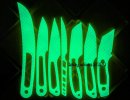I’m a fairly new knife maker and recently told someone my knives seemed rather heavy to me, and he suggested I try making some with tapered tangs. I watched a few youtube videos, and wonder what to do before and what to do after heat treatment. I’ve only used AEB-L so far, and do all my grinding of the bevels post heat treatment. From watching the videos, it seems like for tapered tangs I should do the following.
- drill several holes in the tang
- hollow grind out an area containing the holes
- grind the taper (and make sure it is flat.



